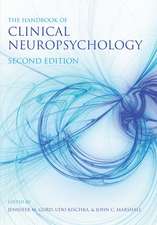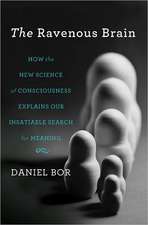Clinical Application of Neuropsychological Test Batteries
Editat de Charles J. Golden, Gerald Goldstein, Theresa M. Incagnolien Limba Engleză Paperback – 26 mar 2012
Preț: 394.51 lei
Nou
Puncte Express: 592
Preț estimativ în valută:
75.49€ • 78.66$ • 62.51£
75.49€ • 78.66$ • 62.51£
Carte tipărită la comandă
Livrare economică 03-17 aprilie
Preluare comenzi: 021 569.72.76
Specificații
ISBN-13: 9781468449938
ISBN-10: 1468449931
Pagini: 428
Ilustrații: XVI, 424 p. 6 illus.
Dimensiuni: 152 x 229 x 22 mm
Greutate: 0.57 kg
Ediția:Softcover reprint of the original 1st ed. 1986
Editura: Springer Us
Colecția Springer
Locul publicării:New York, NY, United States
ISBN-10: 1468449931
Pagini: 428
Ilustrații: XVI, 424 p. 6 illus.
Dimensiuni: 152 x 229 x 22 mm
Greutate: 0.57 kg
Ediția:Softcover reprint of the original 1st ed. 1986
Editura: Springer Us
Colecția Springer
Locul publicării:New York, NY, United States
Public țintă
ResearchCuprins
1 Current Directions and Future Trends in Clinical Neuropsychology.- The Evolving Role of the Clinical Neuropsychologist.- Framework Within Which to Conduct Neuropsychological Evaluation.- Approaches to Evaluation.- Current Issues and Future Directions in Clinical Neuropsychology.- References.- 2 Clinical Interviewing of the Patient and History in Neuropsychological Assessment.- Purposes of the Interview and History in Neuropsychological Assessment.- The Role of the Interview and History in Treatment Planning.- Assessment Methods.- General Summary and Conclusions.- References.- 3 The Role of Standard Cognitive and Personality Tests in Neuropsychological Assessment.- Neuropsychology and the Role of Assessment.- Neurodiagnosis and the Standard Battery.- Assessment Versus Screening.- Future Directions.- Summary and Conclusions.- References.- 4 The Flexible Battery in Neuropsychological Assessment.- Nonfocal Cognitive Deficits and their Evaluation.- Focal Cognitive Deficits and their Evaluation.- References.- 5 Neuropsychological Batteries.- Characteristics of Test Batteries.- Types of Test Batteries.- Theoretical Bias in Battery Development.- A Decision Approach to Systematic Assessment.- The Meaning of Neuropsychological Test Results.- Dimensions of Neuropsychological Assessment.- Assessment of Children and Adults: Special Considerations.- Normative and Criterion Assessment.- Summary.- References.- 6 Overview of the Halstead-Reitan Battery.- Development of the Halstead-Reitan Battery.- Clinical Application of the Halstead-Reitan Battery.- Examples of Neuropsychological Reports.- Future Developments of the Halstead-Reitan Battery.- References.- 7 The Luria-Nebraska Neuropsychological Battery.- The Luria-Nebraska Scales.- Research on the Luria-Nebraska.- Interpretation of the Luria-Nebraska.- References.- 8 An Overview of Similarities and Differences between the Halstead-Reitan and Luria-Nebraska Neuropsychological Batteries.- Historical Considerations.- Similarities and Differences.- Questions and Answers.- Concluding Remarks.- References.- 9 Comparison of Halstead-Reitan and Luria-Nebraska Neuropsychological Batteries: Research Findings.- Studies Using Raters.- Statistical Relationships.- The HRB, LNNB, and Psychometric Intelligence.- The LNNB and the Assessment of Memory.- Concluding Comments.- References.- 10 A Comparison of the Halstead-Reitan, Luria-Nebraska, and Flexible Batteries Through Case Presentations.- A Case of Huntington’s Disease.- A Case of Schizophrenia.- A Case of Mnestic Dysfunction in Thalamic Infarction.- Summary.- References.- 11 Assessment of Aphasia.- The Development of Aphasia Testing.- Principles of Aphasia Testing.- Comprehensive Aphasia Examinations.- Tests of Communicative Function.- Short Screening Tests in Aphasia.- Aphasia Examinations for Polyglots, and in other Languages.- Modality Specific Tests of Aphasia.- Conclusion.- References.- 12 The Clinical Aspects of Memory Disorders: Contributions from Experimental Studies of Amnesia and Dementia.- Comparisons of the Memory Disorders of Patients with Alcoholic Korsakoff’s Syndrome and Patients with Huntington’s Disease.- Conclusions.- References.- 13 Visual-Spatial Disabilities.- Constructional Apraxia.- Recognition and Discrimination of Faces.- Dressing Apraxia.- Optic Ataxia.- Topographical Disorientation.- Neglect.- Perception of Direction.- Conclusion.- References.














